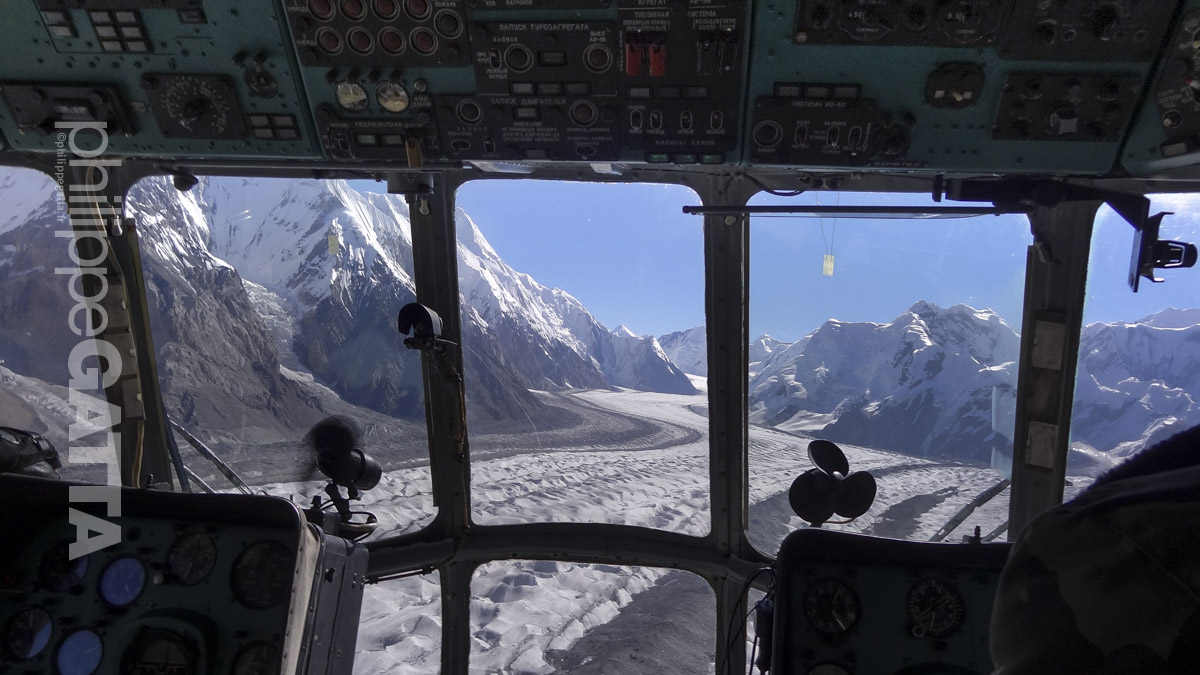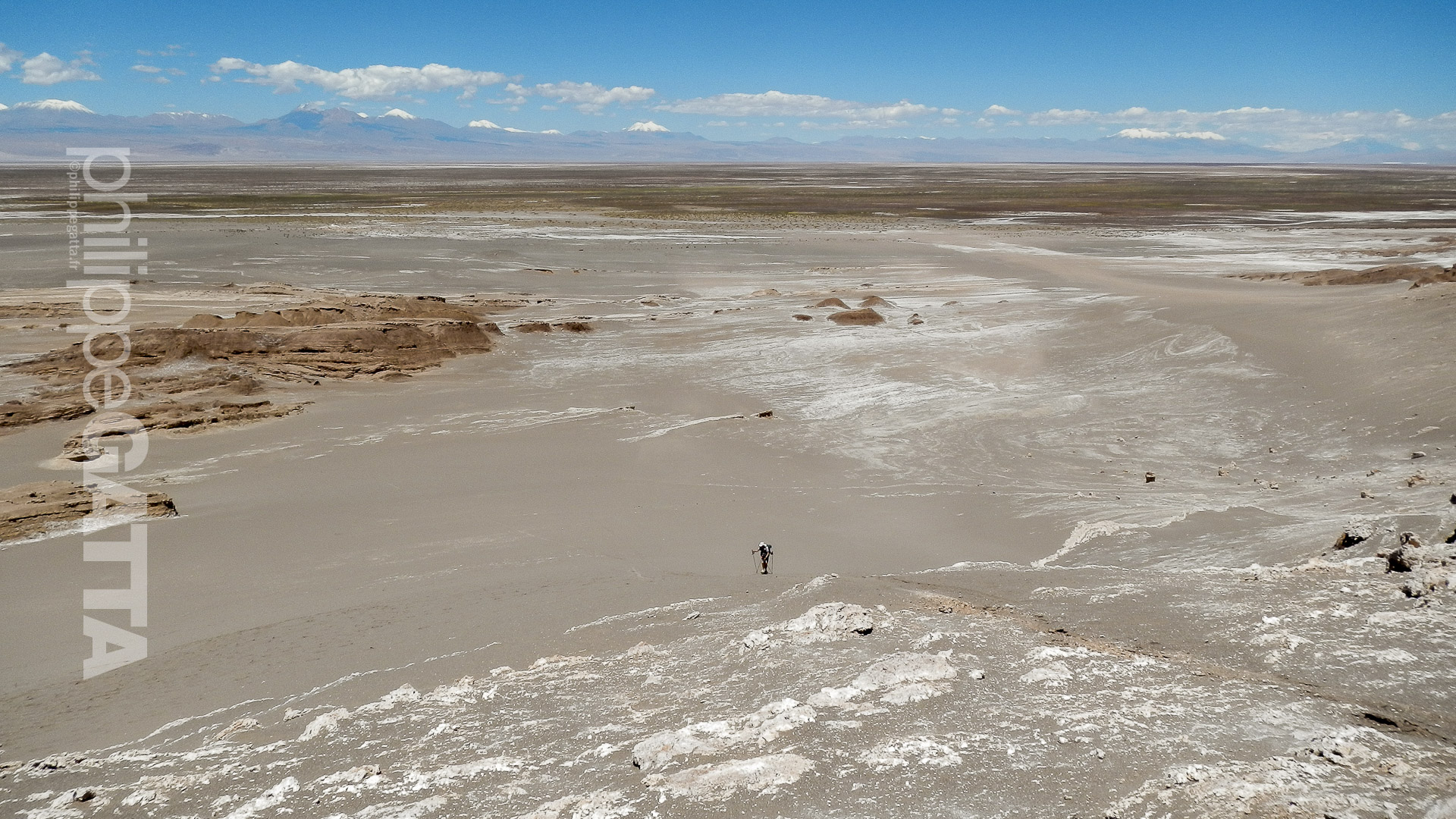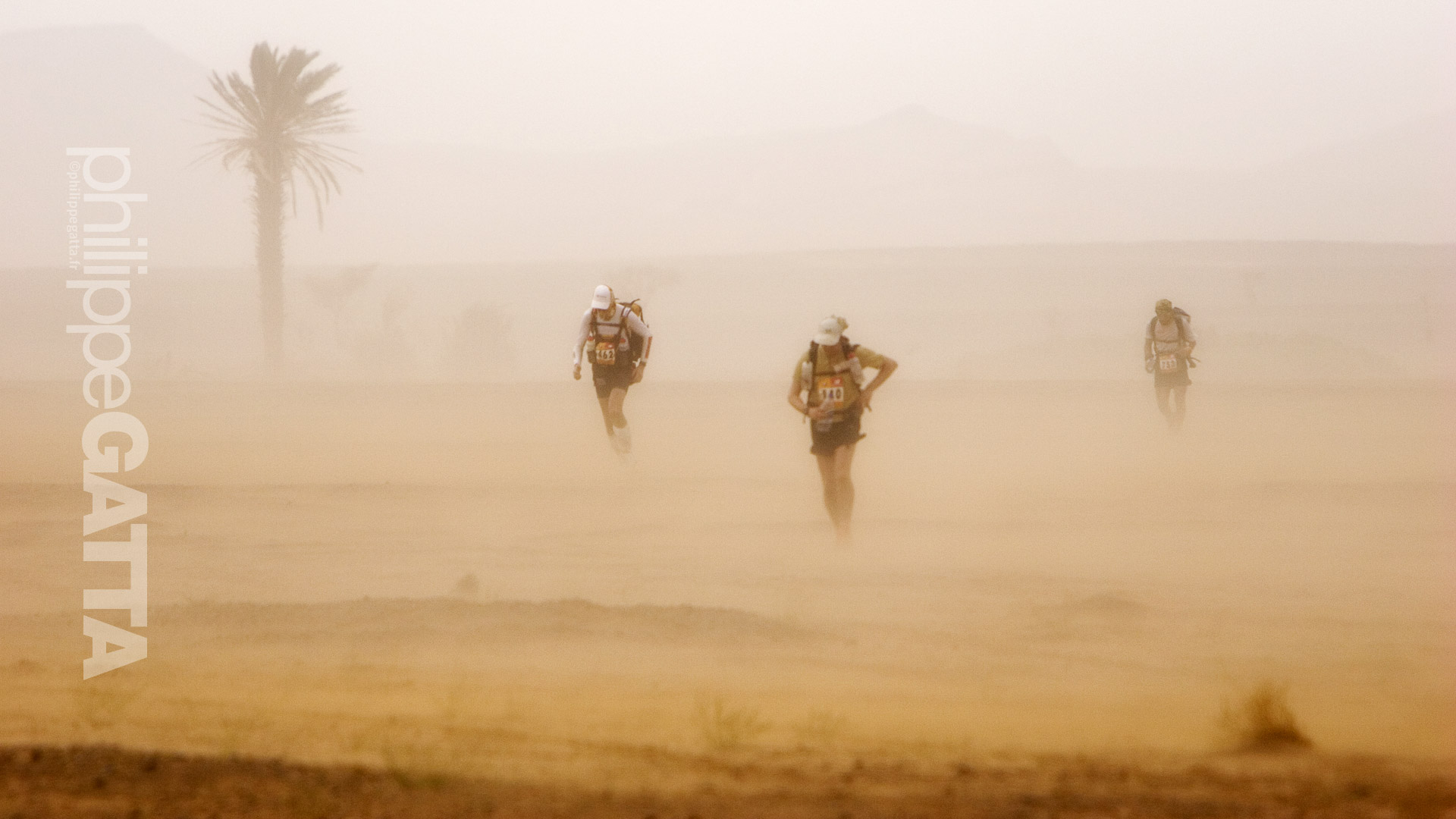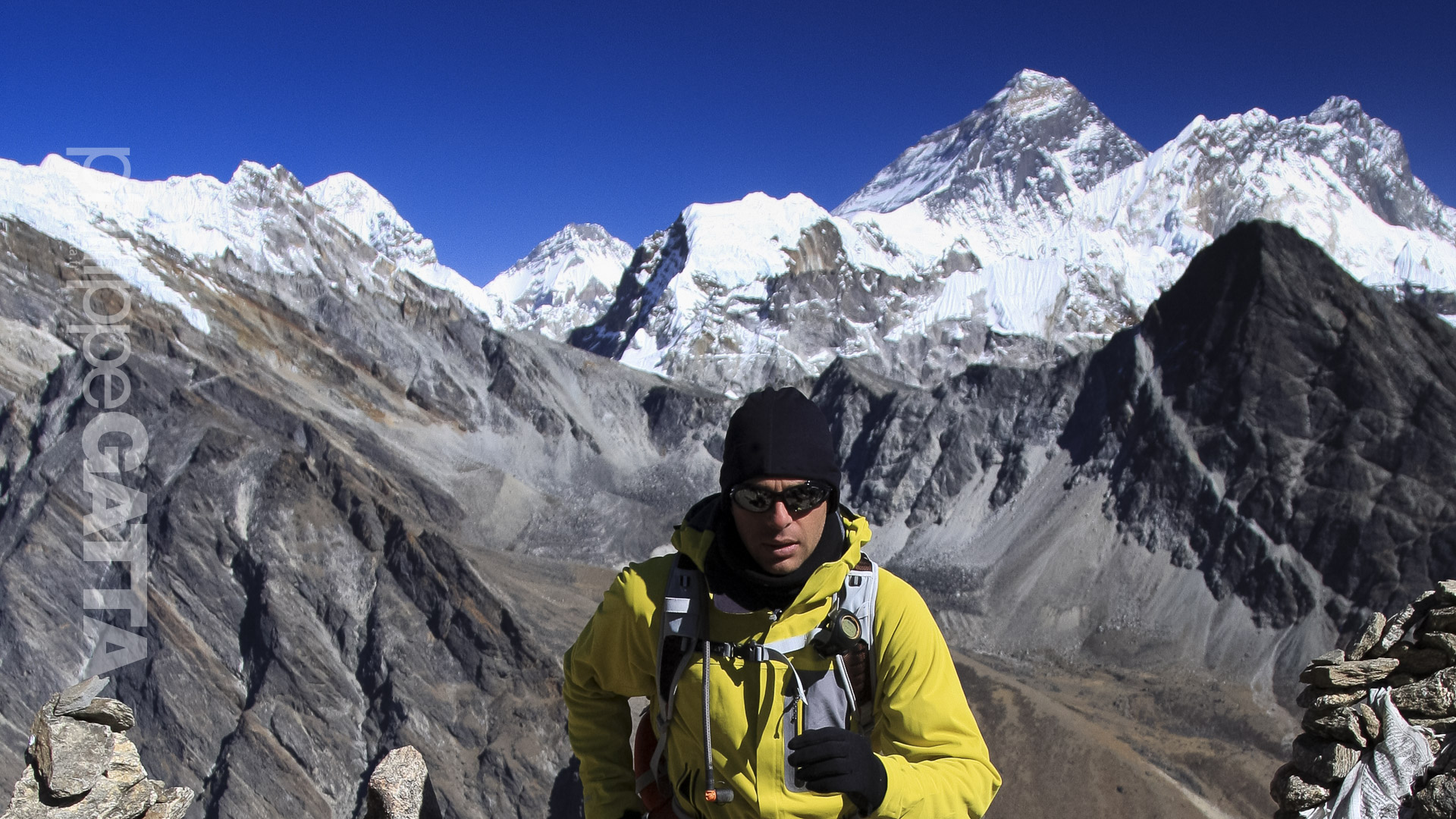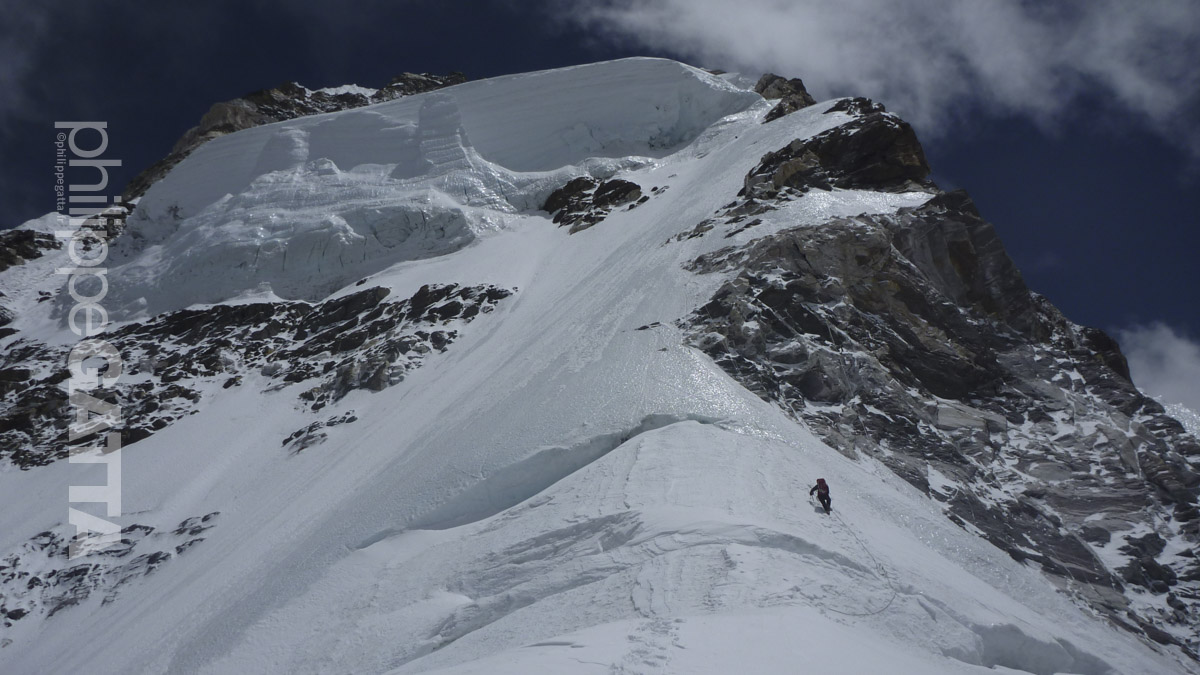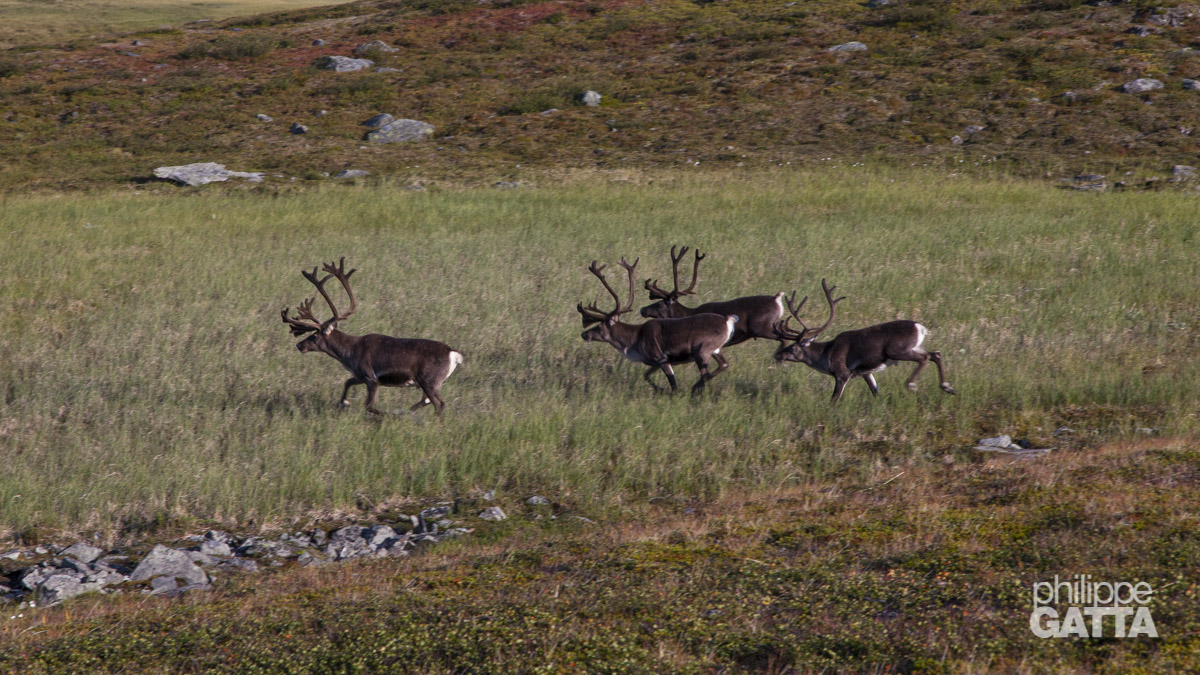Everest Sky Race
200 km trail running race in Kumbu, Nepal

Philippe at the Cho La pass, 5330 m (© A. Gatta)
Introduction
The Everest Lafuma Sky Race is probably one of the nicest mountain trail running races in the world. It takes place in the Khumbu in Nepal, along very famous 8000 meters; Cho Oyu (8153 m), Lhoste (8501 m), Lhoste Shar (8383 m), Makalu (8463 m) and Mt. Everest (8850 m).Bruno Poirier, who created the Annapurna Mandala Trail and the Himal Race, also created the Everest Sky Race. The organization of the race is provided by Base Camp Trek & Expeditions.
The trail of this third edition has been scouted 2006 by Yves Détry, Dominique Bergar and Philippe Pias. It crossed several passes and summits among which ; Nangpal Gotaye (5790 m), Renjo La (5340 m), Gokyo Ri (5350) and Cho La (5420 m). The trail also goes to fantastic places like the Mt. Everest Base Camp (5370 m), Kala Patthar (5540 m), Chhukung La (5130 m), the Gokyo Lakes (4720 m), Gyazumba Tso (5150 m) and the Ama Dablam (4700 m) base camp.
The total distance of the race is 200 km (125 miles) and 11 000 meters (36,090 feet) of climb, in 10 stages.
The Stages of the Everest Lafuma Sky Race
November 11, Stage 1: Lukla (2800 m) - Surkhe (2290 m) - Monjo (2870 m)
Distances and elevation gains: 19 km, +820 m, -830 m. High: 2839 m. Low: 2386 m.Check Point at Surkhe (2870 m), penalty: 2 h
Footing at Lukla before the start of the race (© P. Gatta)
Yangdi Lama Sherpa at the bottom of climb of Namche Bazar (© A. Gatta)
November 12, Stage 2: Monjo (2870 m) - Khumjung (3750 m) - Namche (3440 m)
Distances and elevation gains: 16 km, +1250 m, -630 m. High: 3855 m. Low: 2805 mCheck Point at Khumjung (3750 m), penalty: 2 h and Sanasa (3.600 m), penalty: 4 h.
Philippe Gatta. The Lhotse and Ama Dablam behind (© A. Gatta)
November 13, acclimatization walk from Namche to Tengboche (3850 m)
Distances and elevation gains: 10 km, +815 m, -410 m. High: 3845 m. Low: 3290 mAcclimatization walk from Namche (3440 m) to Tengboche (3850 m).
Tengboche with Lhotse and Everest in the background (© P. Gatta)
November 14, Stage 3: Tengboche (3850 m) - Pangboche (4250 m) - Ama Dablam Base camp (4700 m) - Dingboche (4260 m) - Pheriche (4280 m)
Distances and elevation gains: 17 km, +1120 m, -720 m. High: 4455 m. Low: 3712 mCheck Point at Pangboche (4250 m), penalty: 2 h and at Ama Dablam base camp (4700 m), penalty: 5 h.
Mickaël Delonglée between Tengboche and Ama Dablam BC (© A. Gatta)
Philippe Gatta on the bridge crossing the Imja Khola before climbing 700 m up to Ama Dablam BC (© A. Gatta)
November 15, Stage 4: Pheriche (4280 m) - Chhukung (4730 m) - Chhukung La (5130 m) - Pheriche (4280 m)
Distances and elevation gains: 15 km, +850 m, -850 m.Part #1: of-race walk from Pheriche to Chhukung La with a « stop and go ».
Check Point at Chhukung La (5130), penalty: 6 h.
Part #2: Chhukung La (5130 m) - Pheriche (4280 m) race against the clock. Depart from Chukung La at will.
The Valley from Tengboche to Pheriche. Summits of Nuptse and strong wind on Lhotse. Pumori on the left (© A. Gatta)
November 16, Stage 5: Pheriche (4280 m) - Kala Patthar (5540 m) - Dughla (4600 m)
Distances and elevation gains: 23 km, +1575 m, -1230 m. High: 5550 m. Low: 4550 m.Part #1: of-race walk from Pheriche to Dughla with a start at 4am. At Dughla, the runners will have to carry only the mandatory equipment. They can leave the rest in the lodge where they will sleep in that night. The start of the part #2 will be grouped.
Part #2: Dughla (4600 m) - Kala Patthar (5540 m) - Dughla (4600 m).
Check Point at Gorak Shep (5170 m) and at Kala Patthar (5540 m), penalty: 6 h with a « stop and go ».
Note: there will be a time limit and oxygen saturation check at Gorak Shep. Runners in trouble due to the high altitude or exhaustion will have to go back to Dughla. The penalty will be the time of the last runner + 10 hr. Attention: those who will be late at the check point won't be allowed to go to the Mt. Everest base camp and will go straight to the Kala Patthar.
Philippe Gatta at the top of Kala Patthar, on the left the Mt. Everest and the Ice Fall, on the right the Nuptse (© P. Gatta)
Fabien Brusson descending from the Kala Patthar with the camera on his hand. Pumori in the background (© P. Gatta)
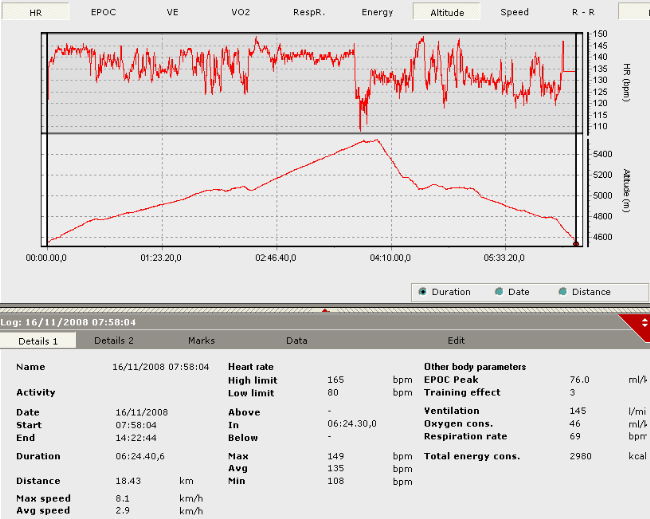
Heart Rate, altitude, distance, speed, Vo2Max, Calories... recorded by the Suunto T6 and the Foot POD (© P. Gatta)
November 17, Stage 6: Dughla (4600 m) - Cho La (5420 m) - Dragnak (4640 m) - Machhermo (4470 m)
Distances and elevation gains: 19 km, +1055 m, -1245 m. High: 5263 m. Low: 4340 m.Check Point at Cho La (5420 m), penalty: 6 h and Dragnak (4640 m), penalty: 2 h.
Looking toward the West from the Cho La (5330 m) (© P. Gatta)
Anna Gatta in the snowy part of Cho La (© A. Gatta)
November 18, Stage 7: Machhermo (4470 m) - Gokyo Village (4750 m) - Thonak Tsho (4900 m) - Gokyo Ri (5350 m) - Gokyo Village (4750 m)
Distances and elevation gains: 13 km, +1110 m, -215 m. High: 5315 m. Low: 4400 m.Check Point at Thonak Tsho Lake (5150 m), penalty: 6 h, Gokyo Ri (5350 m), penalty: 6 h.
Note: going down from Gokyo Ri to Gokyo Village will be done as of-race walk.
Maryse Dupré (runner and doctor) arrive at the top of Gokyo Ri at 5350 m (© P. Gatta)
Philippe Gatta at the top of Gokyo Ri at 5350 m. Mt. Everest is behind (© A. Gatta)
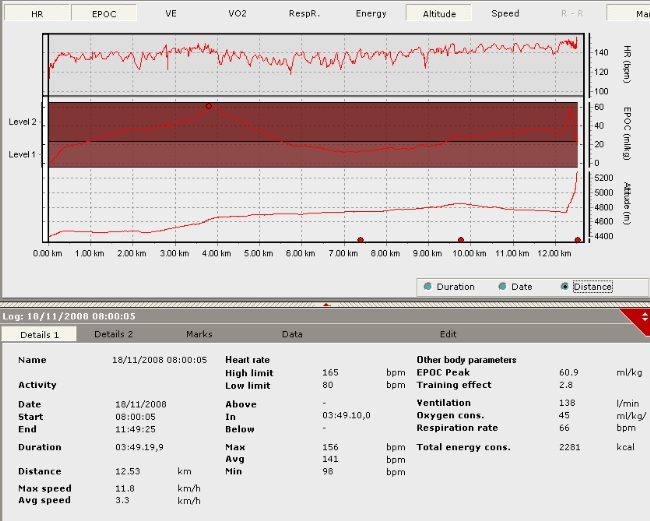
Heart Rate, altitude, distance, speed, Vo2Max, Calories... recorded by the Suunto T6 and the Foot POD (© P. Gatta)
November 19, Stage 8: Gokyo Village (4750 m) - Renjo La (5340 m) - Langden (4340 m)
Distances and elevation gains: 11.5 km, +655 m, -1030 m. High: 5350 m. Low: 4373 m.Check Point at Renjo La (5340 m), penalty: 4 h.
End of the stage at Lungdeng (4470 m) (© P. Gatta)
November 20, Stage 9: Lungdeng (4340 m) - Llunag (5090 m) - Tibetan Camp (4605 m) - Lungdeng (4340 m) - Thame (3800 m)
Distances and elevation gains part #1: 6.5 km, +330 m, -80 m.Distances and elevation gains part #2: 15.6 km, +135 m, -915 m.
Part #1: Lungdeng (4340 m) - Tibetan Camp (4605 m).
Check Point at Tibetan Camp, penalty: 6 h.
Part #2: Lungdeng (4340 m) - Thame (3800 m).
Philippe Gatta and Fabien Brusson (runner and cameraman). Strong wind on the Cho Oyu (© P. Gatta et Patrice Coutaz)
The Team at the start of the 9th stage (© P. Gatta et Patrice Coutaz)
November 21, Stage 10: Thame (3800 m) - Namche (3440 m) - Lukla (2800 m)
Distances and elevation gains: 28.5 km, +935 m, -1850 m. High: 3840 m. Low: 2625 m.Check Point at Namche Bazar (3440 m).
Runners on the bridge at the bottom of the hill of Namche Bazar (© A. Gatta)
Rules of the Everest Lafuma Sky Race
Generality
Everest Lafuma Sky Race 2008 is organized by Base Camp Trek & Expeditions, Nepalese agency in Katmandu, Nepal. The race director is Puré Gurung. The race is limited to 30 runners, including 25 westerners.Everest Lafuma Sky Race 2008 is open to men and women above 23 years old and meeting the following requirements: 1. Experience in mountain race ; 2. Experience in multi-stages races ; 3. Experience of high altitude (4800 m / 15,800 feet) or hypoxic test matching an altitude of 5000 m ; 4. Mountaineering grade of AD (assez difficile) ; 5. Proven results in trail running, or mountain running race ; 6. Experience in orientation race (map reading and usage of compass).
The twenty five (25) first runners meeting those criteria's will be selected for the 2008 edition of the Everest Lafuma Sky Race. This stage competition will take place on trails over a distance of 250 km and 14,000 meters of total positive elevation and 14,000 meters of total negative elevation. The race will include ten (10) stages. The organization, Base Camp Trek & Expeditions, keeps the right to modify the trail if the weather conditions, natural event, medical or political or for any other reasons, require it. Also if the high altitude puts at risk some runners of the Everest Lafuma Sky Race 2008, one stage could be modified into an acclimatization day or walk day.
A team of 20 persons, employees of Base Camp Trek & Expeditions Nepalese agency located in Katmandu, organizes the Everest Lafuma Sky Race 2008 they will take care of the race management and the runners security. The technical team of Base Camp Trek & Expeditions will be split in several groups spread out along the trail to handle stop-watches, check points, lodging and meals (breakfast and dinner).
Runners will be autonomous during each stage, i.e. they ll have to handle the orientation with a map from start to finish and with several check points. Between the check points, runners may choose their on trail but must follow the race director recommendations. Runners may run or walk using poles but must be careful to not hurt anyone. After the first stage, two groups will be defined; group 1 (from 1st to 15th) and group 2 (from 15th to 30th) and two starts will be scheduled after the 1st stage. Note that the groups will evolved based on the ranking after each stage.
In Nepal, the main mean of travel is by foot, so there are many people along the trail and the runners may ask help to locals. However, they will have to use their orientation skills and rely on their on analysis.. The trail of the Everest Lafuma Sky Race 2008 is not marked so map reading is key. Based on the options chosen, the runners may run more kilometers or spend more times to look for the trail. That makes the beauty of the outdoor races.
Philippe Gatta at Namche Bazar (© A. Gatta)
Mandatory equipment of the Everest Lafuma Sky Race
Every participant to the Everest Lafuma Sky Race 2008 will have to carry mandatory equipment from start to finish. The rucksacs will be checked along the race. In case of missing mandatory items, runners will have a 2 hours penalty and will have to find the missing items before carry on. The list of mandatory gear for each runner : rucksack, sleeping bag (- 15 extreme), wind stopper and breathing jacket in Gore-Tex ® or similar, a life blanket, a head torch with extra batteries, whistle, mirror, medical kit including bandage, personal medicine (runners must be self sufficient) against infection, compulsory medicines (a list twill be provided), a flask, a camelbag or similar with 2 L, a carabineer, three (3) meters of dynamic rope (8 mm minimum), a pair of crampons in steel or aluminum and 2,000 calories of food. Poles are recommended. Runners may carry additional gear if they wish.
Patrick Lothodé going to Namche Bazar (© A. Gatta)
Food stations
During the race, the runners must be self sufficient and must manage their own food and water. They can buy food before the start or re-supply during the race. Beside a few sections and stages, they will cross villages every 30 minutes. They can find snacks, biscuits, power bars, chocolates, or dal-bat between 10am and noon.Water is not an issue. We can find water in each village and there are plenty of streams and rivers. Water is everywhere and can be found every 30 minutes, except on the Pass. However, runners must used water pills (Micropur, 1 pill for 1 L). Wait for at least an hour before drinking the water, so the best is to have multiple bottles. It is also possible to buy water bottle in the villages at their own expense: 80 to 200 roupies (0,60 to 3 euros) per litter depending on the altitude.
During the 12 days of the Everest Lafuma Sky Race 2008, the organization will take care of the lodging, breakfasts and dinners. The food will be based on rice, pastas, potatoes and cereals. Runners will be on their own for the lunches, expect 300 roupies (4 euros) per day. Note that beside tea, every other drink will be paid by the runners.
Anna Gatta at the top of Gokyo Ri. The lake and the village of Gokyo below and the Cholatse behind (© P. Gatta)
Solidarity between runners
During the Everest Lafuma Sky Race 2008, solidarity between runners must be the rule and every runner must provide help to other in danger and will be disqualified if they don't. Every runner must know the basis of rescue. Respect and friendship, during and after the race is expectedIn case of altitude sickness, heart problem, breathing problem, fall or hypothermia, the runner in trouble must alert the closest person. If that's a runner, he/she must close to the sick person and provide help if he/she can. He/she must wait for the arrival of the organization team to resume the race. His/her time spent helping will be removed. If another runner arrives, he/she must call the technical staff. The back and forth time be will removed and a 1 minute bonus will be given for each 5 minutes of rescue. The runners will estimate this time and the race director will trust him.
Runners not complying to these rules will be out of the race and will have to join Katmandu by his/her own means.
Puré Gurung and part of the Nepalese Team at Gokyo village. Cho Oyu behind (© P. Gatta)
